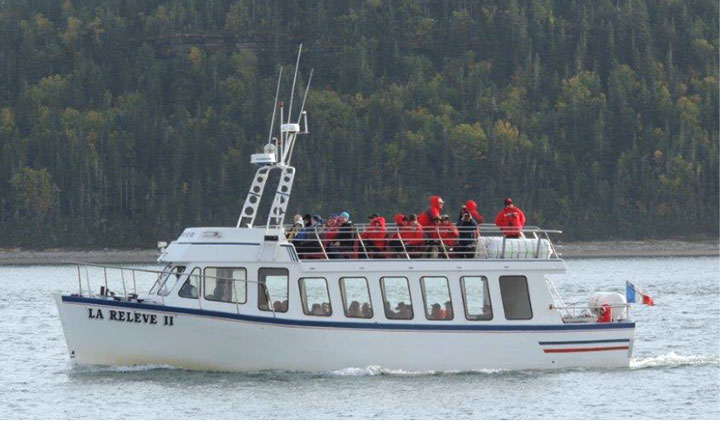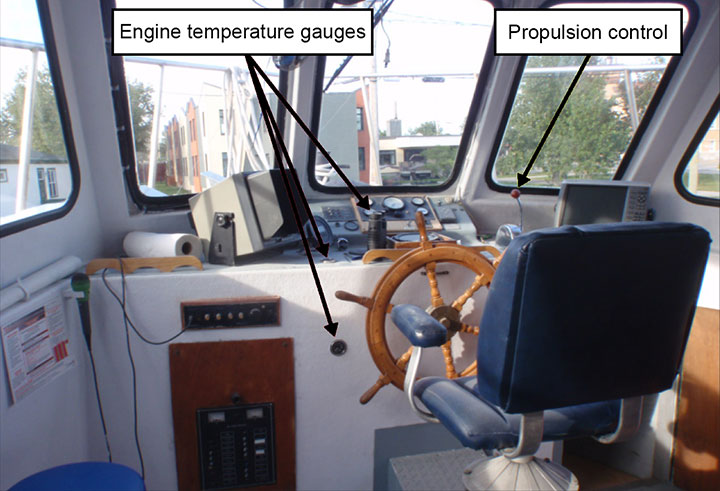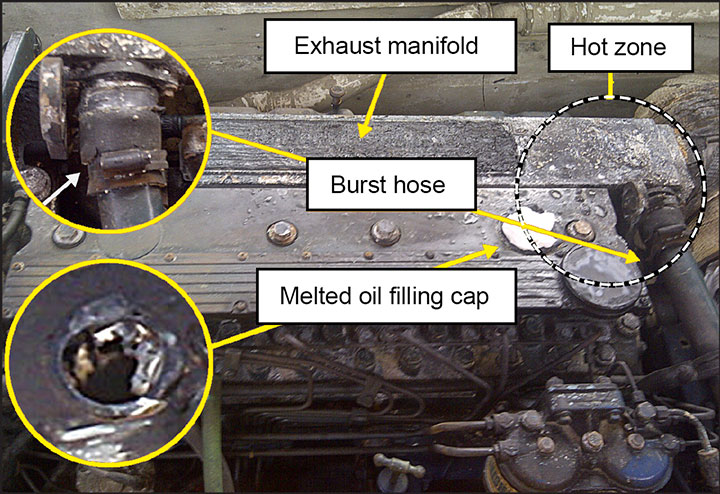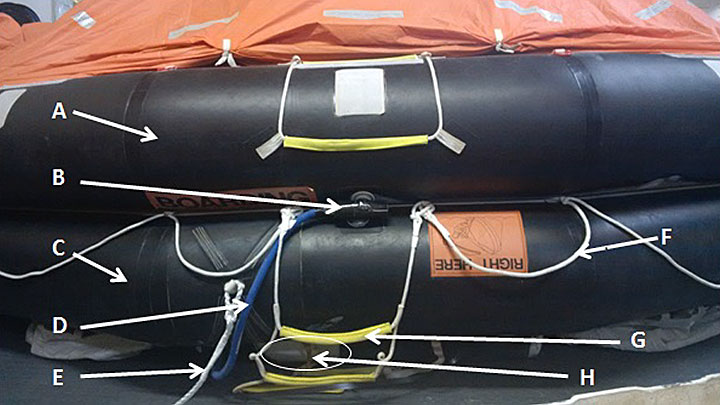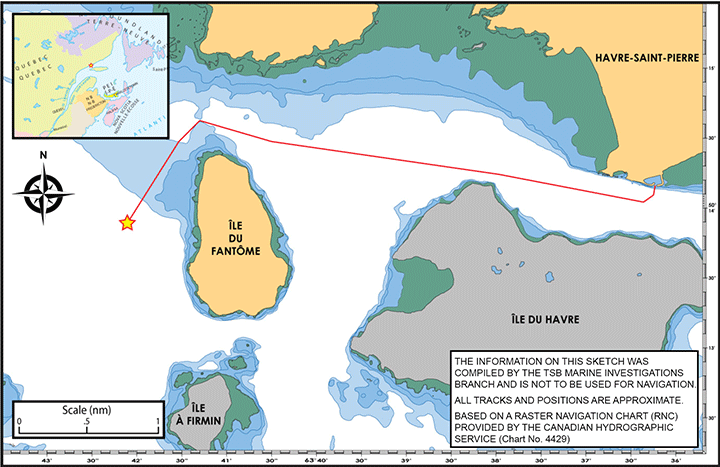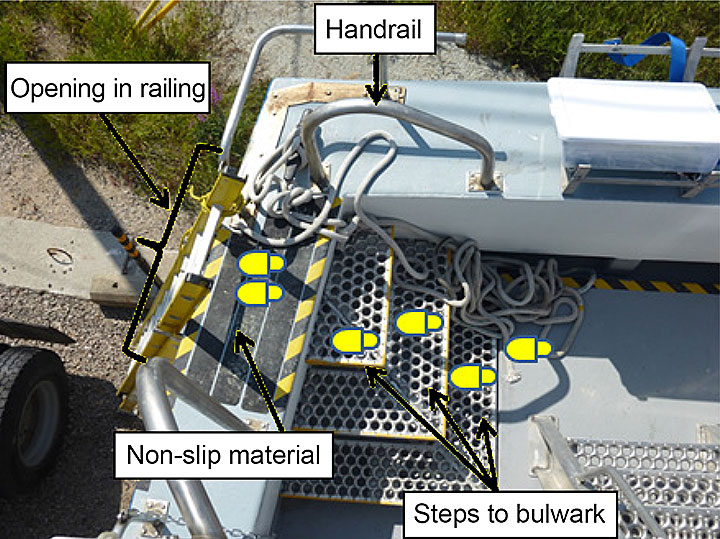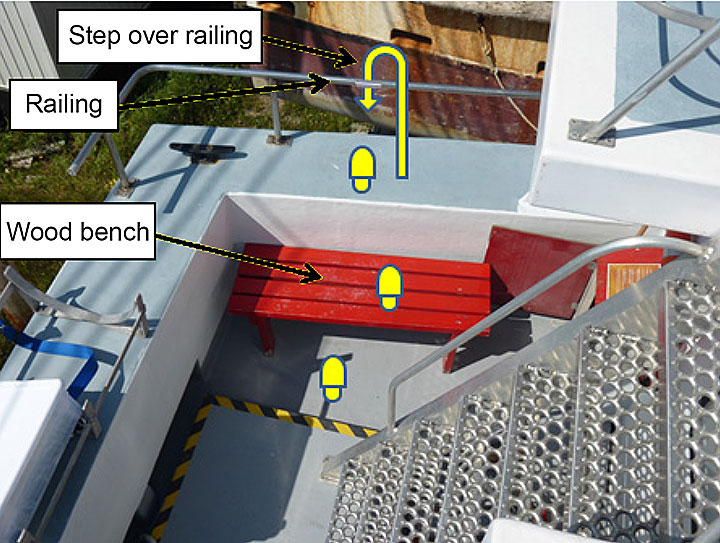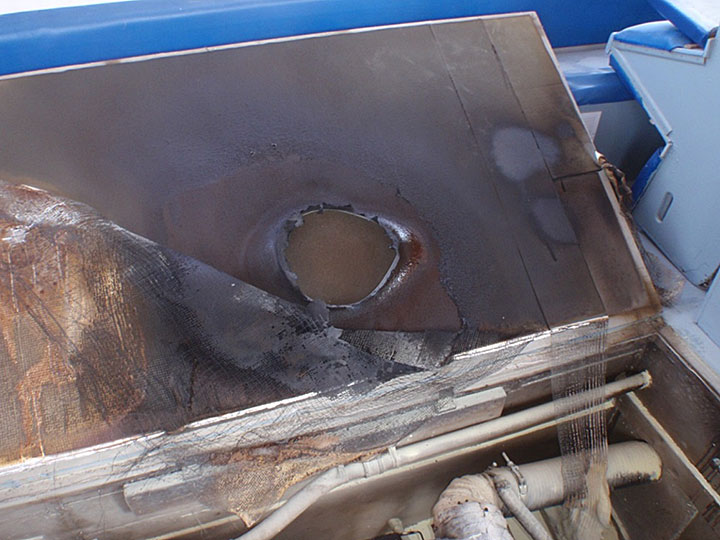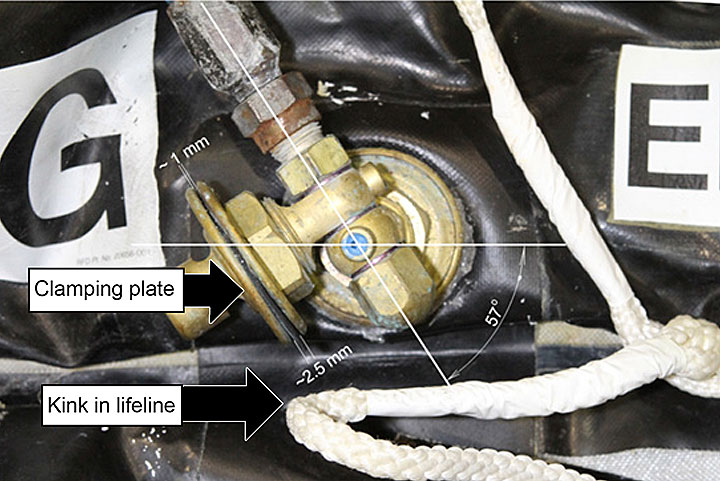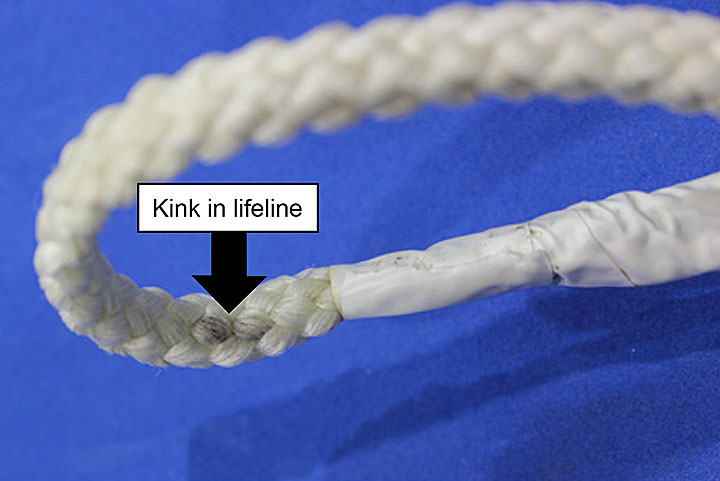Fire and abandonment
Small passenger vessel La Relève II
Havre-Saint-Pierre, Quebec
The Transportation Safety Board of Canada (TSB) investigated this occurrence for the purpose of advancing transportation safety. It is not the function of the Board to assign fault or determine civil or criminal liability. This report is not created for use in the context of legal, disciplinary or other proceedings. See Ownership and use of content. Masculine pronouns and position titles may be used to signify all genders to comply with the Canadian Transportation Accident Investigation and Safety Board Act (S.C. 1989, c. 3).
Summary
On 11 August 2014, at approximately 1335 Eastern Daylight Time, the passenger vessel La Relève II was on a sightseeing cruise off Havre Saint Pierre, Quebec, when a fire started in the engine compartment. The 33 passengers were evacuated onto 2 of the vessel's life rafts, and then transferred onto 2 commercial vessels that were responding to the emergency. The fire was extinguished by the crew. One passenger was injured during the evacuation of the vessel. There was no pollution, but the vessel's engine and engine compartment sustained damage.
Factual information
Particulars of the vessel
| Name of vessel | La Relève II |
|---|---|
| Official number | 802585 |
| Port of registry | Québec, QC |
| Flag | Canada |
| Type | Passenger vessel |
| Gross tonnage | 37.09 |
| Length | 16.62 m |
| Built | 1983 |
| Propulsion | 1 diesel engine (137 kW) driving a fixed-pitch propeller |
| Maximum complement | 47 passengers and 2 crew |
| Complement at occurrence | 33 passengers and 2 crew |
| Registered owner | Air Richard Propane Inc. |
| Manager | Services Maritime Boréale |
Description of the vessel
La Relève II is a small 2-deck passenger vessel (Photo 1) based in Havre-Saint-Pierre, Quebec. The vessel is constructed of wood and covered with fibreglass. Access to the main deck is via the open stern. Forward of this point, the main deck is enclosed within a cabin that includes the conning station and seating for passengers. The upper deck is open and is fitted with additional passenger seating. Access to the upper deck is via stairs at the stern.
The navigation console includes a magnetic compass, radar, and a very high frequency (VHF) radiotelephone. The engine panel, situated in front of the conning position, includes various indicators for engine parameters (e.g., oil, voltage, revolutions per minute, engine temperature). There are 3 engine temperature gauges on the navigation console: 1 on the engine panel, 1 located to the left of the helm, and 1 located at knee height (Photo 2). These gauges indicate the engine coolant temperature. The console also includes a fire detection system consisting of a visual and audible alarm that is activated by a heat detector located in the engine compartment. The detector was installed on the after bulkhead of the engine compartment, which was as far from the engine as possible.Footnote 1 The propulsion control is located to the right of the engine panel.
The vessel is powered by a diesel engine situated in a compartment amidships, on the centreline of the vessel, below the main deck. The compartment is accessed through a floor panel in the cabin. Seating must be removed in order to access the compartment. The engine is supplied with fresh air by 2 vents from the upper deck.
The vessel's firefighting equipment includes a fire pump driven by the vessel's engine, 2 fire extinguishers, and a carbon dioxide (CO2) fixed fire-suppression system with 2 chargesFootnote 2 for the engine compartment. There are also devices to shut off the fuel and air supply to the engine.
The vessel was purchased by its current owner in 2010 and is operated as part of a fleet by a subsidiary of a local family-owned energy distribution company. The family member responsible for the fleet, who is also the authorized representative (AR) Footnote 3 for La Relève II, started his own company 15 years ago with 1 vessel, and has since expanded the fleet to 5 vessels. The fleet is used for daily excursions on a seasonal basis from Havre-Saint-Pierre to the Mingan Archipelago, with a typical season running from early June to late September.
History of the voyage
On 11 August 2014, at around 1200,Footnote 4 the crew, which consisted of the master and the deckhand, began to prepare the vessel for the afternoon cruise scheduled for 1300. The master, who was also acting as the machinery operator, did a visual inspection of the engine compartment and checked for water in the bilges. The master also checked the engine oil level and added 0.25 L of engine coolant. After the 33 passengers had boarded, the vessel left the Havre-Saint-Pierre marina at about 1305 and headed toward the Mingan Archipelago.
Shortly after departure, the master gave the passengers a safety briefing, describing the lifesaving equipment on the vessel and where it was located, and indicating where the passengers were to muster in the event of an emergency.
After the vessel passed the northwest point of Île du Fantôme (Appendix A), the master altered course, heading south for approximately 0.8 nautical miles (nm), at which time the vessel's engine power unexpectedly dropped. The master pushed the throttle control further forward to resume speed, and the engine power increased. However, shortly afterward, the engine power began to decrease again until the engine stopped.
At this time, passengers on the main deck saw smoke coming from around the engine compartment cover and alerted the master. The passengers on the upper deck also saw smoke coming out of the 2 engine-compartment vents. At approximately 1335, the master broadcast a Mayday call on VHF radiotelephone channel 16 stating that there was a fire on the vessel and that they would abandon ship. Marine Communications and Traffic Services (MCTS) Rivière-au-Renard acknowledged receipt of the message and phoned the Quebec Marine Rescue Sub-Centre (MRSC) to inform them of the situation. The MRSC immediately dispatched the Canadian Coast Guard cutter Cap De Rabast, which was based in Havre-Saint-Pierre, to assist. Other vessels in the area also responded to the distress call.
The master informed the deckhand that they would abandon the vessel and ordered the deckhand to prepare the life rafts. He then rushed to the stern and activated the first of the 2 charges of the CO2 fixed fire suppression system. Next, the master went to the forward part of the main deck, closed the dampers for the 2 engine-compartment vents, and shut off the fuel supply to the engine.
Upon receiving the master's instructions, the deckhand went to the upper deck to prepare the life rafts, but then went back to the main deck to confirm whether the life rafts were to be launched. The master then indicated that he would launch the life rafts. By this time, the passengers had begun to don lifejackets and muster at the stern of the vessel.
The deckhand heard a call from MCTS Rivière-au-Renard on the VHF radiotelephone, went to the conning station and responded to it, but eventually had to leave due to the smoke. The deckhand then helped some passengers to don their lifejackets.
Meanwhile, the master went back to the stern and launched the life raft installed there, pulling on the painter to inflate it. The life raft container began to open and both buoyancy tubes began to inflate. However, both tubes lost gas pressure shortly afterwards and deflated, rendering the life raft unusable.
The master then went to the upper deck to launch the life raft on the port side of the vessel. After the painter was pulled, both buoyancy tubes began to inflate, but the lower buoyancy tube deflated shortly afterwards. The life raft was then pulled alongside the vessel.Footnote 5 The life raft on the starboard side of the vessel inflated fully and was also pulled alongside the vessel.
The master helped the passengers board the starboard life raft using the embarkation station. He also ordered the deckhand to take charge of the port life raft. The deckhand, assisted by one of the passengers, helped passengers board the port life raft. To do so, the passengers had to step onto a movable wooden bench, climb over the vessel's railing, and then descend about 1.5 m to reach the life raft (Appendix B).
At 1343, the master informed MCTS Rivière-au-Renard that about 90% of the passengers had boarded the life rafts and that the second charge of CO2 had been released into the engine compartment. The workboat Le Dauphin arrived shortly afterward and began to transfer passengers from one of the life rafts. The passenger vessel Le Capitaine Yockell arrived and began to transfer passengers from the other life raft. In the meantime, the Cap De Rabast arrived and supplied fire extinguishers to La Relève II. The final passenger was transferred directly to Le Capitaine Yockell at 1402, and Le Capitaine Yockell and Le Dauphin headed toward Havre-Saint-Pierre, where the Sûreté du Québec and an ambulance were waiting at the marina. Two passengers were taken to hospital.
After the 2 vessels departed, the Cap De Rabast began towing La Relève II toward the marina. While the vessel was under tow, the master opened the engine compartment cover briefly, discharged 2 fire extinguishers into the compartment, and closed it again. Once La Relève II had moored in Havre-Saint-Pierre, local firefighters boarded the vessel and declared the fire extinguished.
Cause of fire and engine failure
The investigation determined that the engine lost coolant when the rubber hose connected to the exhaust manifold outlet burst (Photo 3), most likely due to wear. Without coolant, the engine became hotter, which eventually caused a crack to develop between the exhaust and water chambers in the exhaust manifold. The damaged hose and crack in the manifold directed the hot exhaust gases onto the underside of the engine compartment cover, which had thermal-acoustic insulation installed on it.Footnote 6 The insulation consisted of 2 layers of polyurethane foam with a layer of vinyl between them, covered by a sheet of aluminized Mylar. This type of insulation provides some soundproofing and thermal protection, but it does not provide protection when it comes into direct contact with a heat source or when the reflective capability of the film is compromised. The hot gases damaged the film, exposing the foam layers. In addition, the engine oil filling cap melted, allowing the engine to spray oil onto the foam. The combination of the oil-soaked foam and heat from the leaking exhaust gases caused the fire.
The leaking exhaust gases, the steam generated from the leaking coolant, and the smoke from the burning foam insulation were drawn into the engine turbocharger, depriving the overheated engine of oxygen and causing it to slow down. The throttle was increased to compensate, and the engine stopped shortly afterwards.
Environmental conditions
Visibility at the time of the occurrence was good, with winds from the east-northeast at 10 knots, light waves, and clear skies. The air temperature was 17°C, and the sea temperature was 11°C.
Injuries
Two passengers were admitted to hospital following the occurrence. One was treated for shock and released shortly afterwards, while the other received treatment for a leg injury sustained during the boarding of the port life raft.
Damage to the vessel
The engine was extensively damaged due to overheating caused by the loss of coolant. The exhaust manifold, the turbocharger, and the cylinder head were rendered unusable. The insulation on the underside of the engine compartment cover was also damaged by the fire (Appendix C). Following the occurrence, the AR withdrew La Relève II from service.
Personnel certification and experience
The master held a certificate of competency as Master Limited for a Vessel of 60 Gross Tonnage or Less and a Small Vessel Machinery Operator (SVMO-R) certificate restricted to La Relève II. The master began working at sea in 1989 and had served as master on La Relève II since May 2010.
The deckhand held a Small Non-Pleasure Vessel Basic Safety (MED A3) training certificate issued in 2009. The deckhand first began working at sea in 2002 and had been a deckhand and tour guide for the company since 2012.
The AR had served as a deckhand part-time for the past 15 seasons. He had completed the Small Vessel Operator Proficiency Training Course in 2010 and a marine emergency duties course in 2004. He also took a fast patrol vessel operator course given by the Canadian Coast Guard in 2004 and participated in a nighttime search and rescue drill in 2004 and 2005. The AR did not hold any certificate of competency.
Vessel certification
La Relève II is inspected annually by Transport Canada (TC). The vessel was issued a certificate as a passenger vessel valid for Near Coastal Voyage, Class 2Footnote 7 on 14 July 2014. The certificate was valid until 31 October 2014. As part of this inspection, the fire detection system was tested by the crew under the observation of a TC inspector and found to be in good working condition.
The inspection certificate was supplemented by a Record of Safety Equipment, issued 24 July 2014, which listed the required safety equipment that was carried on board the vessel.
The vessel had a minimum safe manning document issued on 03 March 2014 that was valid until 02 March 2019. The document stated that the vessel was to be operated with a crew of 2 (1 master and 1 deckhand), one of whom was required to hold an SVMO-R certificate.
Vessel refit
In 2001, a major refit of La Relève II was completed by the previous owner: the hull was covered in fibreglass, the main deck was raised by 30 cm, a new engine and electrical system were installed, new life rafts were installed, and the conning position and passenger space were upgraded.
As part of this refit, the previous owner submitted a General Arrangement plan for La Relève II to get approval for the modifications to be made to the vessel. TC approved the plan in June 2001, subject to certain conditions. These included
- the conning position being isolated from the rest of the vessel by bulkheads;
- the engine compartment cover and the bulkheads around the engine compartment being gastight; and
- all exposed surfaces in the engine compartment having a coat of fire-retardant paint.
On the day of the occurrence, Transportation Safety Board of Canada (TSB) investigators observed that the engine compartment had a coating of fire-retardant paint, but the conning station was not isolated by bulkheads, nor was the engine compartment cover gastight.
Life rafts
To comply with the Lifesaving Equipment Regulations (the LSE Regulations), La Relève II was required to carry life rafts for the maximum complement. The vessel was therefore equipped with 3 inflatable life rafts: 1 on the main deck at the stern and 2 at the after end of the upper passenger deck on the port and starboard sides. Each life raft had a capacity of 20 people. The life rafts were manufactured in June 1999 and were first put into service on La Relève II during its refit in 2001. Prior to this occurrence, they had not been used in an emergency situation.
Life raft servicing
The life rafts on La Relève II had been serviced throughout their lifetime in accordance with the LSE Regulations, and were last serviced in July 2014 by a certified technician at a shore-based facility.
Life raft servicing includes an inspection of the life raft's container, canopy, buoyancy tube, floor, and gas cylinders. An inflation test is performed and any outdated equipment (e.g. batteries, flares, rations, and water) is replaced. When the life raft reaches 10 years of age, and every year after that, it is subject to a necessary additional pressure (NAP) test, where it is inflated at double the normal inflation pressure. The life raft passes the test if no more than a 5% loss of pressure is observed after 5 minutes.Footnote 8 The life raft is then folded back into its container and returned to the vessel's owner. A certificate for the life raft is issued once the inspection is completed.
In Canada, seasonal vessels (operating for less than 7 months of the year) that store life rafts in a dry location when the vessel is laid up can have the interval between inspections increased to every 2 years and even to every 30 months if the life rafts are less than 15 years of age.
Because the life rafts on La Relève II were 15 years old, they had to pass both the NAP test and the standard inflation test. Each life raft passed the tests, was issued a certificate, and was then returned to the vessel's owner.
Life raft failure
When the life rafts were launched at the time of the occurrence, 2 of the 3 did not inflate properly. They were examined by the TSB Laboratory (Photo 4) and the following was noted:
The stern life raft
- The inflation valves for the upper and lower buoyancy tubes were ripped from the buoyancy tubes and the holes in which the inflation valves had been fitted were deformed.
- The upper buoyancy tube had a longitudinal tear about 30 cm long in the area of its inflation valve.
- The lower buoyancy tube had a longitudinal (circumferential) tear about 76 cm long in the area of its inflation valve.
The port life raft
- The inflation valve was ripped from the lower buoyancy tube and the hole in which it had been fitted was deformed.
- The gap between the clamping plates for the lower buoyancy tube was non-uniform due to deformation (Appendix D).
- The upper buoyancy tube was intact and its inflation valve was still attached. However, the inflation valve assembly was turned almost 60° clockwise from its normal, horizontal position (Appendix D).
- The lower buoyancy tube had a longitudinal tear about 76 cm long in the area of its inflation valve.
Aside from the areas around the inflation valves, the outer surface of the buoyancy tubes showed no signs of fraying, abrasion, cuts, or other pre-existing damage. The buoyancy tube material was tested for static tensile strength and met the current International Maritime Organization (IMO) specifications.Footnote 9 However, kinks in the lifeline near the inflation valves were observed on both life rafts (Appendix D). These kinks were permanent, meaning that, even after the lifeline was straightened and released, the kink reappeared in the same location. The painters and boarding ladders did not have kinks or show other signs of entanglement.
Records from the life raft manufacturer indicate that there have been no similar failures on this model of life raft.
Embarkation stations
The LSE Regulations require passenger vessels like La Relève II to be equipped with embarkation stations and a means of boarding the survival craft. However many stations there are, the vessel must be evacuated in 30 minutes: if there is only 1 station, the life rafts must be able to be manoeuvred one by one to the station for boarding, or each life raft must have its own station.
La Relève II was equipped with 1 embarkation station, on the aft starboard side (Appendix B). The station has 3 steps up to the bulwark, which is covered with a non-slip material. Beside the steps is a handrail, and along the bulwark is a railing with an opening to allow passengers to board the life rafts.
Minimum safe manning
The crewing requirements for La Relève II are described in the vessel's minimum safe manning document, which specifies the minimum complement and the required certifications for each crew member. TC uses a standard form, the Minimum Safe Manning Evaluation Form, to determine the minimum complement on board a vessel and to maintain consistency across all regions.Footnote 10
In order to determine the minimum required complement during normal and emergency operations, including evacuation and post-abandonment, TC takes the following criteria into account:
- type of vessel and tonnage
- propulsive power (and whether or not machinery space is periodically unattended)
- watch arrangement
- type and number of lifesaving equipment
- type and number of firefighting equipment
- number of passengers (if applicable)
- trading area (description of voyage)
Following the occurrence, the TSB requested a copy of the minimum safe manning evaluation form used for La Relève II. TC indicated that the form was not used in every instance. When the evaluation form has already been used to determine minimum safe manning for a similar vessel in similar conditions (e.g. type, number of passengers, voyage waters), TC determines that a precedent exists and issues a minimum safe manning document based on this precedent. In the caseof La Relève II, a precedent existed and therefore a minimum safe manning document was issued to the vessel for a crew of 2.
Emergency procedures and drills
Emergency procedures and drills are governed by the Canada Shipping Act, 2001 (CSA 2001) and the Fire and Boat Drill Regulations. The CSA 2001 specifies that the AR on a Canadian vessel is responsible for developing procedures for the normal and emergency operation of the vessel and for ensuring that crew members have received safety training.Footnote 11 The master is then required to assign passenger-related emergency duties to the crew members and inform them of these duties, which may include such things as assistance to passengers, communication, firefighting, launching of lifesaving equipment, and manning of survival crafts after abandonment of the vessel.Footnote 12
To comply with the Fire and Boat Drills Regulations, the crew was required to perform a fire and survival craft drill every 2 weeks.Footnote 13 The regulations also specify that emergency information in both official languages must be posted in passenger areas, indicating things such as:Footnote 14
- the alarm signals used to indicate emergencies;
- the essential actions to be taken during an emergency;
- the locations of designated muster stations; and
- the correct method for donning a lifejacket.
The practice on board was for the crew to conduct passenger safety briefings and for the master to provide on-the-job training for new crew members, including training on the use of the safety equipment on board. At the beginning of the 2014 season, the master had familiarized the deckhand with the vessel's safety equipment and discussed its operation.
It was not the practice of the crew to conduct fire and boat drills, nor was one conducted during the 2014 annual inspection by TC. There was also no emergency information posted on the vessel.
Transport Canada vessel inspections
La Relève II, as a seasonal passenger vessel, is subject to annual inspection by TC to ensure that the vessel is in compliance with the relevant provisions of the CSA 2001 and its regulations.
TSB obtained inspection information for La Relève II for the previous 3 years (2012, 2013, and 2014). Table 2 summarizes the deficiencies related to passenger safety that were identified during the 2013 and 2014 inspections. The vessel received certification after each inspection, and in 2013 had its certificate extended in order to operate for a longer period.
| Date | Inspection results | Deadline for compliance | Compliant? Yes/No |
|---|---|---|---|
| 2013 | Passenger safety briefing to be revised | Within 1 month | Yes (17 July 2014) |
| Evacuation plan to be submitted | Within 1 month | No | |
| 2014 | Lifesaving equipment plan to be submitted | Within 14 days | No |
| Evacuation plan to be prepared and submitted | Within 14 days | No | |
| Passenger safety briefing to be prepared and submitted | Within 14 days | No | |
| Fire and boat drills to be performed on a regular basis and recorded in the vessel log book | Before next voyage | No |
Guidance and instructions for TC marine safety inspectors
Prior to an inspection, the process is for the marine safety inspector to consult the Ship Inspection Reporting System (SIRS) database, which provides the vessel's particulars, history, certificates and their expiry dates, as well as deficiencies identified by previous inspections and their current status. The inspector then prints out the pre-inspection report, which includes inspection items and the dates that they are due for inspection. It also provides a list of the vessel's certificates and any outstanding deficiencies. In addition, the inspector may review the vessel's file for any pertinent information, such as requests to make changes to the vessel or its complement or any plans that have been approved and need to be verified. With this information, the inspector then performs the on-board inspection of the vessel's documentation, hull and machinery, lifesaving equipment, firefighting equipment, and crew certification. It is also the practice of inspectors to witness the conduct of a fire and boat drill at the end of the inspection.
When the inspector identifies a deficiency, the inspector issues a deficiency notice indicating a time frame in which the deficiency must be rectified. For major deficiencies, the inspection certificate can be withheld or a detention notice can be issued. Inspectors use their own judgement to determine if a deficiency is major or minor. They also use their own judgement to set the compliance due dates, which can range from immediate detention to a period of 30 days to rectify the deficiency. When a deficiency is identified, it becomes the responsibility of the AR to ensure that the deficiency is rectified prior to the due date and to inform the inspector of this. There is no guidance for inspectors about whether or not certification should be issued to a vessel on which deficiencies have been identified.
La Relève II was one of 2 small passenger vessels subject to inspection by the local TC service centre. The same inspector had inspected La Relève II for the past 3 years.
Concentrated Inspection Campaign
In 2014, TC conducted a Canada-wide Concentrated Inspection Campaign (CIC)Footnote 15 on fire safety appliances and lifesaving equipment for 60 small to medium-sized passenger vessels (vessels less than 500 gross tonnes and carrying more than 12 passengers). The campaign focused on vessel owners' compliance with the CSA 2001 and looked at vessel procedures for boat and fire drills, passenger counts, and means for assisting passengers with special needs.
TC inspectors found that 45% of the vessels did not have a satisfactory fire control plan. TC inspectors also found deficiencies such as the fire control plan not being on board, or the fire control plan being merged with the lifesaving equipment plan.
Additionally, it was found that 40% of the vessels did not have a satisfactory lifesaving equipment plan, for reasons including the plan not being up to date or not being on board, as well as deficiencies related to the lifesaving equipment plan identified in previous inspections still not being rectified.
Overall, based on the CIC inspections, a total of 29 deficiency notices were issued, which represents 48% of the vessels inspected as part of the campaign.
Post-occurrence vessel examination by TSB
During a post-occurrence examination of La Relève II, TSB investigators identified the following:
- There were no documented procedures for the normal and emergency operation of the vessel, as required by the CSA 2001;Footnote 16
- There were no evacuation procedures, lifesaving equipment plan, or maintenance and training manuals related to lifesaving equipment on board, as required by the LSE Regulations, Part III;Footnote 17
- There was no safety information for passengers posted (including alarm signals, what action to take in an emergency, where muster stations were located, and how to correctly don a life jacket); fire and boat drills were not being performed; and emergency duties were not assigned to the crew, as required by the Fire and Boat Drill Regulations;
- There were no high temperature or oil pressure alarms installed on the engine as required by the Marine Machinery Regulations;Footnote 18
- There were 3 engine temperature gauges at the conning station, and 2 of these were not in working order;Footnote 19 and
- There was polyurethane foam installed in the engine compartment, even though this type of material is prohibited for use on wooden passenger vessels, according to Transport Canada Publication TP 11717, “Standards for the Construction and Inspection of Small Passenger Vessels.”
Safety management system
The principal objectives of safety management on board vessels are to ensure safety at sea, prevent human injury or loss of life, and avoid damage to the environment. Ideally, to manage safety, a vessel operator would identify existing and potential risks, establish safety policies and procedures to mitigate the risks, and then provide a means to continuously gauge effectiveness so as to improve organizational safety where necessary. A documented, systematic approach to safety management (known as a safety management system, or SMS) helps to ensure that individuals at all levels of an organization have the information and the tools needed to make sound decisions in both routine and emergency operations.
The company that owned La Relève II did not have an SMS, nor was the vessel required to have one by regulation.
The TSB has made numerous findings related to SMS, and issued a recommendation related to SMS following the sinking of the amphibious vehicle Lady Duck in June 2002.Footnote 20 In this occurrence, 4 of the 12 people on board drowned because they were trapped in the vehicle. The TSB investigation determined that the company did not have an effective safety management structure or system, in that the procedures concerning the operation of the Lady Duck were informal and undocumented. The TSB recommended that:
The Department of Transport take steps to ensure that small passenger vessel enterprises have a safety management system.
Transportation Safety Recommendation M04-01
TC's most recent response to this recommendation in 2014 maintained that operators of small vessels (those less than 24 m in length and carrying 50 passengers or fewer) will not be required to adopt an SMS. For these vessels TC will promote SMS. The assessment of the response to Recommendation M04-01 remains Unsatisfactory, and the recommendation is still active.Footnote 21
TC's proposed amendments to the Safety Management System Regulations would require an SMS on vessels 24 m or greater in length or carrying more than 50 passengers. For passenger vessels such as La Relève II (less than 24 m in length and carrying 50 or fewer passengers), TC is promoting, but not requiring, SMS.
TSB Watchlist
The Watchlist is a list of issues posing the greatest risk to Canada's transportation system; the TSB publishes it to focus the attention of industry and regulators on the problems that need addressing today.
The TSB has identified safety management and oversight as a 2014 Watchlist issue, noting that some transportation companies are not effectively managing their safety risks. The Watchlist calls for TC to implement regulations requiring operators to have formal safety management processes and for TC to oversee these processes.
Previous occurrences
Previous TSB investigations into occurrences involving passenger vessels in several regions of Canada have identified issues related to emergency preparedness and regulatory oversight.
In July 2010, the passenger vessel River Rouge ran aground in the Quarry Rapids on the Red River, north of Winnipeg, Manitoba. The TSB investigationFootnote 22 found that, without a reference in the Ship Inspection Reporting System (SIRS) to the verification of vessel procedures and policies or guidelines for the assessment of their adequacy, TC inspectors may not include this critical aspect of vessel safety. TC updated the SIRS database in response to issues found during the investigation.
In October 2012, the roll-on/roll-off passenger ferry Jiimaan grounded on the approach to Kingsville Harbour, on Lake Erie in Ontario. The TSB investigationFootnote 23 into this occurrence determined that the shipboard plans and procedures for mustering and accounting for passengers were not comprehensive, and that drills were conducted with only crew members, which meant that crew were not able to practise passenger management duties in a realistic way.
Furthermore, it was determined that TC inspections did not verify that the duties or procedures related to passenger safety as required by the regulations were included in the shipboard procedures. The Board issued a safety concern, stating that if TC inspectors do not assess muster lists and evacuation plans for compliance and adequacy, and if TC does not provide interpretive guidelines, compliance with passenger safety regulations may be inadequate, thereby negating the potential safety benefits of such regulations.
In May 2013, the passenger vessel Louis Jolliet ran aground off Sainte-Pétronille, Île d'Orléans, Quebec, while on a cruise with 57 passengers on board. The TSB investigation into this occurrenceFootnote 24 concluded that
- If all crew members are not properly trained in emergency procedures, there is a risk that crew members will not fulfill their assigned roles effectively in an emergency.
- If crew members do not have comprehensive, documented procedures and realistic drills for passenger safety management tasks, there is a risk that crew members will not be able to carry out these tasks effectively in an emergency.
In response to issues raised during the investigation, TC added fields to the SIRS database requiring inspectors to verify that the muster list contains the information required by the Fire and Boat Drill RegulationsFootnote 25 and that the emergency procedures are complete and relevant to the vessel and include procedures for instructing crew and passengers.Footnote 26 Inspectors were also reminded that, during muster and evacuation drills, crew members assigned to passenger control tasks should demonstrate a clear understanding of their assigned duties.Footnote 27
In November 2013, the passenger ferry Princess of Acadia, carrying a total of 87 passengers and crew, sustained a blackout and went aground while approaching the ferry terminal at Digby, Nova Scotia. The TSB investigation into this occurrenceFootnote 28 noted issues similar to the Louis Jolliet pertaining to emergency procedures and drills. It was also found that, if Transport Canada oversight to ensure compliance with regulations regarding passenger safety emergency procedures is ineffective, there is a risk that these procedures will not achieve their intended purpose.
TSB laboratory reports
The TSB completed the following laboratory reports in support of this investigation:
- LP158/2014 – Examination of Insulation Material
- LP159/2014 – Examination of Life Rafts
Analysis
Events leading to fire and abandonment
While the vessel was underway toward the Mingan Archipelago, the engine slowed down unexpectedly as a result of an engine malfunction. A fire in the engine compartment started at this time or shortly afterward. There were no alarms at the conning station to alert the master of an engine problem. Of the 3 engine temperature gauges, the only one that worked was located at knee height and required a person to bend down in order to read the gauge. The master responded to the engine's deceleration by increasing the throttle to resume the original speed. However, this caused the engine to overheat and fail completely. It also introduced more heat and oil into the compartment, creating favourable conditions for the fire.
The passengers alerted the master that smoke was emanating from around the engine compartment cover. At this time, the fire detection system had not yet activated. The master released the first of the 2 charges of CO2 of the fixed fire extinguishing system into the engine compartment, which lowered the temperature in the compartment and may have prevented the fire detection system from activating.
The master then initiated an evacuation of the vessel. However, only 2 of the life rafts were usable, as the third had immediately deflated. Kinks in the lifelines, deformation of the clamping plates, and the location of buoyancy tube ruptures indicate that the lifelines may have become entangled with the inflation valve assemblies. When the life rafts inflated, the entangled lifelines would have created localized strain around the clamping plates that held the inflation valves in the buoyancy tubes, tearing the inflation valves from the life raft. There was no information to indicate that the life raft had been opened other than for servicing in the previous month. Despite the life raft failure, the master and the deckhand were able to successfully evacuate all 33 passengers.
Emergency preparedness
During an emergency, the safety of a vessel and its complement (particularly passengers who are unfamiliar with the vessel and its emergency procedures) is dependent on prompt and appropriate actions by crew members. Developing an evacuation plan and then documenting emergency duties in written procedures, specifically assigning those duties to crew members, and regularly practising them helps to ensure a coordinated and effective response.
Although the master and the deckhand on La Relève II had familiarized themselves with and discussed the operation of the on-board safety equipment at the beginning of the season, they did not have written procedures or assigned duties in case of an emergency, nor di d they conduct fire and boat drills. As a result, when the emergency situation unfolded, some shortcomings were evident in their response. For example:
- both the master's and deckhand's responses to the emergency were improvised, and they both took action, but their actions were not always prioritized in the correct order (e.g. the master discharging the CO2 before closing the engine compartment vents) and they provided assistance where they deemed it was the most needed;
- the crew did not notify the passengers of the emergency at its onset, and the passengers were left to draw their own conclusions based on cues around them (e.g. vessel stopping, presence of smoke);
- passengers began donning lifejackets themselves without the benefit of posted instructions or assistance from the crew;
- the life rafts were not launched immediately, as the deckhand was unsure if this was what the master intended; and
- the passengers boarded the life rafts from both sides of the vessel, despite the fact the port side was not suitable as an embarkation station.
In this occurrence, the crew had sufficient time to successfully oversee the evacuation of the passengers (a partial complement) into the life rafts, although 1 passenger sustained a minor injury while boarding the port life raft. However, under different circumstances such as a rapidly spreading fire and a maximum passenger complement, such shortcomings had the potential to reduce the chances of a successful outcome. This occurrence illustrates the importance of evacuation plans, emergency procedures, training, assigned duties, and regular drills on all passenger vessels, as the inherent risks are the same, regardless of size and crew complement.
Previous Transportation Safety Board of Canada (TSB) investigations, such as the ones involving the Jiimaan, Louis Jolliet, and the Princess of Acadia, have identified similar shortcomings with the management of passengers during an emergency.
If crew members do not have written emergency procedures, specifically assigned emergency duties, and training in these duties, there is a risk that they will not fulfill their roles effectively in an emergency.
Adequacy of regulatory oversight
Transport Canada (TC) inspections have a central role in identifying deficiencies that may impact the safety of a vessel and/or its complement.
In the case of La Relève II, the vessel was issued certification over multiple years despite missing documentation and outstanding issues that had not been rectified. Some of these outstanding issues date as far back as the vessel refit in 2001, when it was identified that the conning station needed to be isolated with bulkheads and the engine compartment cover needed to be gastight. Although deficiencies had also been identified during annual inspections, in some cases the AR had not taken action to rectify the deficiencies and there was no follow-up by TC. For example, during the July 2013 inspection, the marine safety inspector had identified that an evacuation plan needed to be prepared for the vessel and had issued a deficiency notice with a deadline of 1 month. In September, the AR requested a 1-month extension of the certificate, but had not yet prepared an evacuation plan. However, the extension was granted. The vessel was then issued a certificate to operate in 2014 despite the fact that an evacuation plan still had not been prepared.
TC's 2014 Concentrated Inspection Campaign (CIC) revealed similar issues relating to deficiencies in lifesaving equipment plans that had been identified in previous inspections but not rectified. This means that other vessels likely received certification despite having major deficiencies in their lifesaving equipment plans.
These issues may be occurring in part because TC does not provide guidance or instructions to inspectors as to which specific deficiencies should result in a vessel certificate not being issued, a certificate being issued but for a restricted period, or a certificate being issued but the vessel being immediately detained. Moreover, inspectors are not provided with criteria on how to classify a deficiency (minor or major).
Without guidance to assist TC inspectors in assessing the severity of a deficiency, there is a risk that vessels will be certified and operated despite the presence of major deficiencies.
Previous TC inspections of La Relève II also did not identify a number of deficiencies, some of which related to passenger safety. For example, neither the 2012 nor the 2013 inspection identified that the vessel was missing a lifesaving plan and that the crew were not conducting fire and boat drills.
For most aspects of a vessel's inspection, inspectors use the Ship Inspection Reporting System (SIRS) database as an aide-mémoire for the items to be inspected. However, it is missing some specific regulatory requirements. For example:
- the requirement for a passenger vessel to have an evacuation plan, lifesaving equipment plan and associated training and maintenance manuals, as per the Lifesaving Equipment Regulations, Part III (the LSE Regulations);
- the requirement for safety information to be posted in passenger areas, as per the Fire and Boat Drills Regulations; and
- the requirement for engines to be maintained and safety devices to be correctly adjusted and operational, as per the Marine Machinery Regulations.
Thus, the pre-inspection reports used by inspectors do not prompt them to check on some critical items related to vessel safety. In order to supplement the pre-inspection reports, inspectors must consult the regulations, the vessel's file, ship safety bulletins, and notices from various sources, opening up the possibility that inspectors may miss some safety-critical items during their inspections.
Previous TSB investigations, including those involving the River Rouge and Louis Jolliet, identified similar issues related to the SIRS database. While those issues were corrected, there are still some safety-critical requirements missing from the database.
If the SIRS database does not include all safety-critical requirements to be verified during an inspection, there is a risk that vessels may receive certification despite the presence of major deficiencies.
Minimum safe manning
When issuing a minimum safe manning document, TC has a responsibility to accurately determine the minimum crew complement that a vessel can carry while still ensuring safe operations in both normal and emergency situations.
La Relève II had been issued a minimum safe manning document that was based on a precedent and did not take into account the actual characteristics of the vessel and its equipment. The minimum safe manning document was issued for a crew of 2; however, there were 3 life rafts on board. This meant that there were not enough certificated crew members for each of the life rafts (1 certificated crew member per life raft is required by the Marine Personnel Regulations).Footnote 29 In a situation where the vessel had been carrying the maximum passenger complement and all 3 life rafts had been put in service, there would not have been a crew member available to man the third life raft after abandonment.
If a minimum safe manning document does not take into account the actual characteristics of the vessel and its equipment, there is a risk that there will not be sufficient crew to carry out emergency duties.
Safety management
Effective safety management requires large and small organizations to be cognizant of the risks involved in their operations, to competently manage those risks, and to be committed to operating safely. A safety management system (SMS) is a documented, systematic approach to ensure safe practices in vessel operations and to promote a safe working environment. It obliges the establishment of safeguards against all identified risks and continuous improvement of the safety management skills of personnel ashore and on board vessels. SMS must be tailored to the needs of the operation, and even small companies need to have safety processes in place to manage risk.
Currently, TC does not have regulations mandating the implementation of an SMS on domestically operated vessels like La Relève II. Although it is the operator's commitment that forms the cornerstone of safety management, regulatory frameworks do provide motivation and valuable guidance in the development and implementation of an SMS. In this occurrence, the company did not have a formal process for managing safety. There were no procedures established for the safe operation of the vessel in both normal and emergency situations, nor for the conduct of emergency drills.
If vessel operators do not have a formal process for managing safety, there is an increased risk that hazards will not be identified and effectively mitigated.
Findings
Findings as to causes and contributing factors
- La Relève II's engine lost coolant when the rubber hose connected to the exhaust manifold outlet burst. The engine then overheated, causing a crack to develop in the exhaust manifold.
- The damaged hose and crack in the manifold directed the hot exhaust gases onto the underside of the engine compartment cover, damaging the insulation and exposing the layer of polyurethane foam.
- A fire started in the engine compartment after the foam became soaked in oil and exposed to the hot exhaust gases.
Findings as to risk
- If crew members do not have written emergency procedures, specifically assigned emergency duties, and training in these duties, there is a risk that they will not fulfill their roles effectively in an emergency.
- Without guidance to assist Transport Canada inspectors in assessing the severity of a deficiency, there is a risk that vessels will be certified and operated despite the presence of major deficiencies.
- If the Ship Inspection Reporting System (SIRS) database does not include all safety-critical requirements to be verified during an inspection, there is a risk that vessels may receive certification despite the presence of major deficiencies.
- If a minimum safe manning document does not take into account the actual characteristics of the vessel and its equipment, there is a risk that there will not be sufficient crew to carry out emergency duties.
- If vessel operators do not have a formal process for managing safety, there is an increased risk that hazards will not be identified and effectively mitigated.
Other findings
- The insulation installed in the engine compartment contained polyurethane foam, which is prohibited for use on passenger vessels.
- Two of the 3 life rafts failed to inflate fully due to buoyancy tube ruptures at the inflation valves. The ruptures may have been caused by the lifelines becoming entangled with the inflation valve assemblies and creating excessive strain in the tubes.
Safety action
Safety action taken
Transportation Safety Board of Canada
On 19 September 2014, the TSB issued Marine Safety Advisory LetterFootnote 30 (MSA) 07/14 to inform Survitec Group Limited, the manufacturer of the life rafts, about the malfunction of the 2 life rafts in an emergency situation and the damage that they sustained.
On 24 September 2014, the TSB issued Marine Safety Information LetterFootnote 31 (MSI) 07/14 to inform Transport Canada (TC) about the risks associated with the use of thermal-acoustic insulation incorporating aluminized Mylar in machinery compartments. While this type of insulation may provide adequate thermal protection during normal machinery operation, it can be severely damaged or catch fire in the case of an engine fire or malfunction, such as when oil sprays onto the insulation's reflective surface. The letter also stated that aluminized Mylar is no longer used in insulation in aircraft since it was found to have been a factor in the Swissair Flight 111 accident (TSB Aviation Investigation Report A98H0003).
Survitec Group Limited
On 09 October 2014, Survitec Group Limited responded to TSB MSA 07/14, stating that its preliminary investigations revealed that the life rafts had last been serviced in July 2014 by a manufacturer-approved facility and that they had passed all of the prescribed tests.
Survitec then identified a number of potential failure modes for further investigation and testing. An MK1 20-person life raft manufactured in 1987 was taken from service and brought to Dunmurry, Northern Ireland, to try to replicate the failure. However, the testing could not replicate the failure.
The life raft used for the testing at Dunmurry was sent to Survitec's certified technician in Montreal, Quebec, where service personnel inspected, packed, and tested the life raft, with TSB and Survitec Dunmurry personnel in attendance.
In addition, Survitec representatives travelled to Ottawa, Ontario, in January 2015 to examine the damaged life raft at the TSB Laboratory.
Transport Canada
In April 2015, TC issued FLAGSTATENET Notice 01-2015 reminding inspectors to review the approved plans for vessels and to verify any notations in red to ensure a thorough inspection. Notations requiring follow-up are to be acknowledged during the inspection and included in the final inspection report. If they have not been complied with, a deficiency notice is to be issued following the inspection and action is to be taken by the owner to rectify the deficiency.
In April 2015, TC issued FLAGSTATENET Notice 02-2015 informing inspectors of the contents of MSI 07/14 and reminding them to pay particular attention to surface material requirements for each vessel being inspected. Some vessels, such as passenger vessels, are required to have materials with low flame spread characteristics that will not produce excessive quantities of smoke or toxic fumes when ignited. If surfaces are found to be covered with flammable material, a deficiency notice is to be issued for the situation to be rectified. If a vessel is found to have insulation incorporating aluminized Mylar in engine compartments or other spaces with a high fire risk, inspectors are to inform TC headquarters of the vessel's name, official number, and details of the material installation.
This report concludes the Transportation Safety Board's investigation into this occurrence. The Board authorized the release of this report on . It was officially released on .
Appendices
